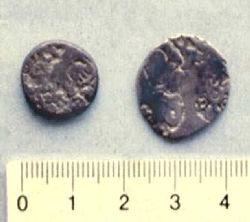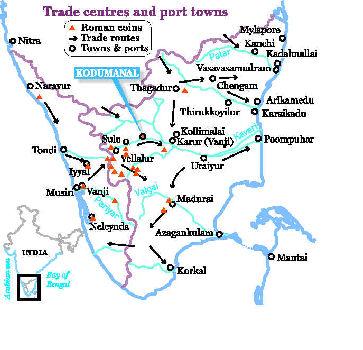T.S. Subramanian
Source - http://www.frontline.in/stories/20120810291507000.htm

Punch-marked Roman coins found in Kodumanal. K. RAJAN
Kodumanal, celebrated in Tamil Sangam literature (datable from the second century BCE to the second century C.E.), is now one of the most explored sites in India. The Sangam work Pathitruppatthu refers to Kodumanal as Kodumanam in two places. While the poet Kabilar refers to it as “Kodumanam patta… nankalam”, another poet, Arisil Kizhar, celebrates it as “Kodumanam patta vinaimaan arunkalam”, that is, Kodumanam, the place where rare jewels are made. A horizontally excavated site, Kodumanal has yielded the highest number of inscribed potsherds (about 315 potsherds with Tamil-Brahmi inscriptions) and also the largest number of exposed graves for any single archaeological site in India.
It was V.N. Srinivasa Desikan of the Archaeological Survey of India (ASI) who first noticed Kodumanal’s antiquity in 1961. R. Nagaswamy, then Director, Tamil Nadu State Department of Archaeology, made a trial excavation there in the 1980s. Nagaswamy credited S. Raju, a scholar in Tamil and then Professor of Epigraphy, Tamil University, Thanjavur, with discovering Kodumanal. Raju first highlighted Kodumanal’s archaeological potential by his frequent visits to the site and the paper he presented in the World Tamil Conference held in Madurai in 1981. He supported the observations he made in his paper with a large number of antiquities he collected from the site. All this made Y. Subbarayalu of Tamil University direct K. Rajan, then a research scholar in the university, to explore the Coimbatore region. Rajan discovered more than 120 archaeological sites for his PhD thesis on the megalithic sites of the Coimbatore region.
A series of excavations started in 1985. “Every season was a success and success has followed every trench. The success will continue,” said Rajan. Tamil University excavators dug 48 trenches and exposed 13 megalithic graves in 1985, 1986, 1988 and 1990, with Subbarayalu as the Director of Excavation and Rajan actively associated with him. Each trench covered a four-square-metre area. The Department of Ancient History and Archaeology, University of Madras, and the Tamil Nadu State Department of Archaeology collaborated with Tamil University to a limited extent. “The excavations in the habitation mound covered a fairly big area and may be classified as area excavation,” said Subbarayalu. Later, the State Department of Archaeology excavated another 15 trenches and exposed three more megalithic graves in 1998 and 1999.
In April and May 2012, it was the turn of Pondicherry University, encouraged by its Vice-Chancellor, Professor J.A.K. Tareen, to resume the excavation at Kodumanal with K. Rajan as its director. He had a team of young, enthusiastic research scholars – V.P. Yathees Kumar, S. Selvakumar, R. Ramesh, A. Perumal, P. Balamurugan and P. Ramesh – who took part in the excavation, funded by the ASI and the Central Institute of Classical Tamil, Chennai. Four trenches that were excavated this year revealed the remains of an industrial complex, while two megalithic graves with cist burials shed light on the majesty of the cist burial and funerary customs of the period concerned. Yathees Kumar, who had worked under Rajan in the previous excavations at Thandikudi and Povanthal, both in Tamil Nadu, said he was glad that he could take part in the excavation at an ancient site like Kodumanal.

Kodumanal lies on the ancient trade route that connected the Chera capital of Karur (Vanji) on the east with the famous Chera seaport of Musiri on the west coast in present-day Kerala. Roman coin hoards have been found in several places in this region. Roman coin hoard sites such as Vellalur and Eyyal are located on this route. A major Roman coin hoard of 522 denarii (silver coins) was found in an earthen pot at Vellalur in 1841. Roman coin hoards of 547 denarii and 12 denarii were found in 1891 and in 1931, and gold jewellery with Tiberian aureole (gold coins) were found at Vellalur in 1939. Kattankanni, another Roman coin hoard site, is situated 5 km west of Kodumanal. A hoard of 233 denarii of Augustus and Tiberius was found at Kattankanni in 1913.
Rajan said: “These coins vouchsafe for the trade this region had with the Roman world. The provenances of these coins would suggest an ancient trade route passing along the banks of the Noyyal river from the ports on the west coast to Karur and further east. Greek and Latin writers of the first and second century C.E. have spoken about beryl, quartz and other jewel stones figuring prominently in Roman trade.”
There is a late 15th century C.E. inscription near the Noyyal river that describes the boundaries of the village. It is clear that Kodumanal was a big village at that time. It is a sprawling village even today with vast open spaces and tidy-looking houses. There is an air of cleanliness everywhere. The roads are smooth and macadamised. Even today, there is no tea stall to be seen in the village where Rajan searched for one in vain in 1983. The use of plastic is banned. G. Selvaraj, son of late Govindasamy Gounder, is the village president. Selvaraj’s brother, G. Ramachandran alias Somu, and their families are archaeology buffs and they have helped the excavations in every way.